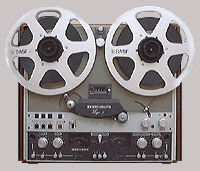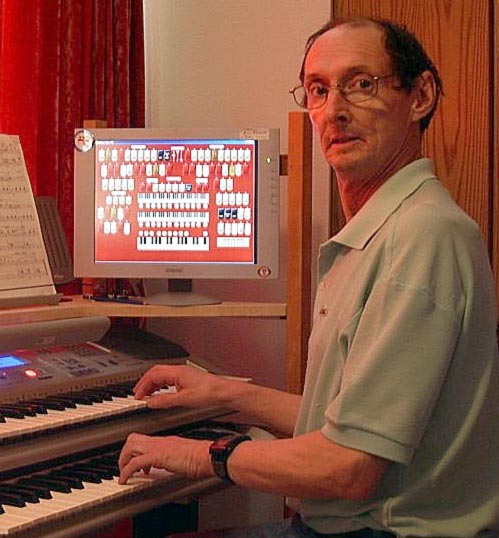
|
|
Russ Ashworth, Vancouver, Canada
Here we see Russ Ashworth doing something he absolutely loves to do, that is, playing his Mighty MidiTzer! He is featured on the Walnut Hill Wall of Fame. To see the evolution of, and learn more about, his Mighty MidiTzer virtual TPO setup, click here. We quote him below: Hi everybody. Just to introduce myself: I now live in Vancouver, British Columbia, having moved here from England 13 years ago. When I lived there I used to go to the local Theatre Organ Preservation Society concerts and thrill to the choral sounds of swirling Tibias. I bought a small Yamaha organ (all I could afford at the time) with the idea of learning to play so that, if ever there was a chance to play a real theatre pipe organ, I would be prepared. After many years of trying to find even one registration that might sound just a little bit like a Theatre Pipe Organ if you squinted real hard, I gave up on playing but hung onto my three foot high stack of music books and instruction manuals plus some records. One day I thought maybe, just maybe, I would find a way to play again on something that sounded like a proper Theatre Organ. Meanwhile, I watched as computer technology changed organs by adding such things as automatic rhythm units, one finger chords, and one finger accompaniments. The number of stops and voices became less. The number of "features" became more, as in, more programing and less choices. Prices went up, sizes went down, and organs evolved into the home keyboard and then into the ultimate one finger music machine, the mp3 player. Surely, the ultimate triumph of technology and marketing over flexibility and freedom of expression. Apart from a short time with a Yamaha home keyboard and a Roland MIDI Pedal board, that had been it for my organ playing experience. My problem is, there isn't a Theatre Organ within hundreds of miles of here now. Probably thousands, if I look only in Canada. Then, in October of 2004, I found Jim Henry's Mighty MidiTzer. Jim has been very diligent about accuracy to the original Mighty WurliTzer Style 216 it is modelled after. Just like those who "fly" flight simulators, using a MidiTzer means lots of questions about real Theatre Pipe Organs. I had more fun and satisfaction that first evening setting up the previously useless registrations out of my old music books and playing them from the computer keyboard than I got from the previous 10 years of playing that old Yamaha organ. I finally crawled into bed at three in the morning with a big smile on my face. Russ Ashworth's Music
Russ Ashworth's Comments About His MusicThis page was not my idea, but came about because of The Bone Doctor's enthusiasm for the Mighty MidiTzer Virtual Theatre Pipe Organ. This is not about me, but is about MidiTzer, which has really changed my life in ways that I could never have imagined and are too numerous to list here. It is about a Theatre Organ that anybody can own. If you have a home keyboard and an old PC with a Soundblaster card, you can own a Mighty WurliTzer and a little piece of entertainment history. If so, you have the space and half the equipment already. At this stage, registration is what it is all about for me. It is a novelty that I haven't had in previous organs. I hope that, as my playing improves, I shall update the material on this page. I enjoy a lot of different music. Often a tune will just pop into my head and I have to play it. Last week, I ended up playing Satie's 1st Gymnopodie. It is a piano piece but I first heard it played on a synthesizer by Gary Numan. (My wife thought I should hear it). I listened to it over and over again. Even now, I can sing it to myself with all the parts. I love it and long ago I bought the music. Why play it on a Theatre Organ? Because it is beautiful, and because I can. What other instrument can play such a variety of music? The Pedals are Tibia 8' and Diapason 8'. The Accompaniment is Diapason 8', Viol 8', Celeste 8', and Flute 8' playing 3 note chords. These are accompanying the Solo Oboe 8' (which is a quiet stop) and a Tibia 4'. To correct the imbalance between the manuals (14 "pipes" against 2), I have split the swells and the main swell is almost closed. Most people associate Glenn Miller with Moonlight Serenade, but few know that he also recorded Moonlight Sonata by Beethoven. (Another musical introduction from my wife.) The melody was taken by his well known Sax and Horn combo. I have tried to capture the sound here. Once again, it is all Miditzer. I didn't have the sheet music for it, so I had to make it up. Therefore, there isn't very much of it Yet. Mark Knopfler of Dire Straights has written music for several films including Cal, Last Exit to Brooklyn, The Princess Bride, and Local Hero. The CD Screenplaying covers the music from all of these films, and is one of those I have to listen to with my eyes closed (no I don't play it in the car). This tune, The Misty Covered Mountains, was written for the film Local Hero. It is set on the West coast of the Scottish Highlands. It is very atmospheric. This is another song that I wanted to recreate, and I have tried to stay as close to the original sound as I could. The sheet music I have for it is written for Piano with guitar chords, so there is not much to go on. I don't know that I would have been able to do much better if I had had a full score, because it would have been too complicated for me and would not be my interpretation of it. I am finding that I start with the registration to get the mood I want, and then see what I can do with the rest of it. I start looking for notes that move smoothly from one chord to the next, padding or thinning the notes as seems to be appropriate. The registration slowly develops, the chords develop, and eventually it develops a life of its own. Then comes the hard part. Trying to play it all the way through without any mistakes. Playing it for myself is fun because there is always next time, but recording it is a problem. So, once again I say, this is not about my playing ability but what the Mighty Miditzer can do and it is all Miditzer. The first phrase is played with a Tibia 8' on the Solo, Diapason 8' on the Accompaniment, and Tibia 8' and Flute 8' on the Pedals. The Main Swell is half closed to reduce the volume of the Diapason and Flute. The Accompaniment is played using slow broken chords played staccatto against a very breathy Tibia sound played leggatto. The slow attack of a pipe means that playing staccatto reduces the volume. Think pipes and not electronic. The rest of it is played with both hands on the Solo manual. In the second phrase, the accompaniment is played with longer chords which starts to fill out with the Tibia sound. I bring in the Octave coupler for the third phrase, giving a brighter and fuller, but still smooth sound. This phrase is also slightly different and uses some higher notes. The last phrase I play an octave higher. The whole thing gives a building of sound using just phrasing, pitch and one Octave coupler. As you all know "Our" organ, the one that MidiTzer is based on, was recorded by George Wright himself before it's removal after the fire. I have been playing his "Live" CD's about twice a day over the past couple of months. One of the tunes that stuck in my mind from that CD was One Fine Day from Madamme Butterfly. A couple of days before I recorded this, I went into a used book store on the off chance that they might have some organ music books. Well, they had six almost new condition books, one of which contained the music for One Fine Day, filling seven pages in this book. The music contained 5 registration changes. So, I loaded these into the Combination Memory and amazed myself by being able to play it. Not only that, but it sounded fantastic on my little MidiTzer, almost as good as George Wright playing the real one, I have convinced myself. You should be able to hear the registration changes, and if you can't, please e-mail me. The registration I used is as follows: Combination 1
Solo: Tibia 8', 4', Viol d'Orchestre 8', Celeste 8', Oboe 8' Combination 2 Solo: Strings (Viol d'Orchestre 8', Celeste 8') -Off- Combination 3 Solo: Add Flute 16' Combination 4 Solo: Flute 16' -OFF- Combination 5 Solo: Flute 16', Strings 8' -On- When I did this I was Alpha testing MidiTzer v0.40, which has a crescendo pedal. The last blast is the results of my crescendo pedal programing and playing it all on the Solo manual with one hand while I operated the slider for the pedal control with the other. An easier way is to play both hands on the Solo as a block chord for the first eight bars or so. It really isn't that difficult. In fact, I am getting to the point where I can play most of it without the music. It is all chords. I am not certain what key it is, perhaps one flat, so it should be F but it goes into the minor alot. The melody starts on F, then D, F, D, F, and E. Just follow the melody. Do try this at home kids. :) The chords are held long, with smooth changes (Laggetto) with the pedal playing the same bass note. So, "F F C C" means hold F for two bars, and then C for two bars. The chords are F, F, C, C, D, D, C, C, Gm, Gm, Am, Am, C7Sus4 (this is A#, C and F with a C pedal dropping to C7, F, and F.) As you play this song, think that One Fine Day we may have "Our" organ back where it belongs. See the Rialto Wurlitzer 216 group on Yahoo! to learn more about this instrument. |
